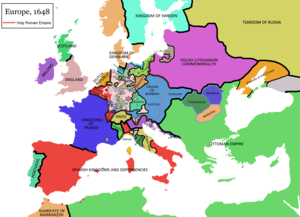മുപ്പതുവർഷ യുദ്ധം
യൂറോപ്പ്യൻ ചരിത്രത്തിലെ ഏറ്റവും വിനാശകാരിയായ സംഘട്ടനങ്ങളിലൊന്നായിരുന്നു മുപ്പതുവർഷ യുദ്ധം (1618–1648). പ്രധാനമായും ജർമൻ പ്രദേശങ്ങളിലായിരുന്നു യുദ്ധം നടന്നതെങ്കിലും യൂറോപ്പിലെ എല്ലാ രാജ്യങ്ങളുംതന്നെ ഏതെങ്കിലും അവസരത്തിൽ ഈ സംഘർഷത്തിൽ ഉൾപ്പെട്ടിരുന്നു. ഇതിന്റെ ഭാഗമായ നാവികയുദ്ധം യൂറോപ്പിനു വെളിയിലെ കോളനികളുടെ അതിരുകൾ മാറ്റിമറിയ്ക്കുകയും ഭാവി രാജ്യങ്ങളുടെ രൂപവത്കരണത്തിനു വഴിതെളിക്കുകയും ചെയ്തു.
യുദ്ധം തുടങ്ങാനുള്ള സാഹചര്യവും പോരടിക്കുന്ന രാജ്യങ്ങളുടെ ലക്ഷ്യങ്ങളും സങ്കീർണ്ണമായിരുന്നതിനാൽ ഏതെങ്കിലും ഒരു കാരണം മാത്രം യുദ്ധകാരണമായി പ്രസ്താവിക്കാൻ സാധ്യമല്ല. ആദ്യമൊക്കെ യുദ്ധം വിശുദ്ധ റോമാസാമ്രാജ്യത്തിലെ പ്രൊട്ടസ്റ്റന്റുകാരും കത്തോലിക്കരും തമ്മിലുള്ള ഒരു മതസംഘട്ടനമായിരുന്നെങ്കിലും പിന്നീട് സാമ്രാജ്യത്തിലെ അഭ്യന്തരരാഷ്ട്രീയകലഹങ്ങൾ മുൻനിർത്തിയുള്ള ഒരു സംഘർഷമായി അത് വളർന്നു. ക്രമേണ യൂറോപ്പ്യൻ ശക്തികളെല്ലാം തന്നെ ഉൾപ്പെട്ട ഒരു ഗംഭീര യുദ്ധമായി.[9][10] യുദ്ധത്തിന്റെ ഈ ഘട്ടത്തിൽ യൂറോപ്പ്യൻ അധീശത്വത്തിനായുള്ള ബോർബോൺ-ഹാബ്സ്ബർഗ് കിടമത്സരത്തിന്റെ തുടർച്ചയായി സംഘർഷം മാറുകയും ഒരു മതസംഘട്ടനമെന്നതിലുപരി ഫ്രഞ്ച് ഹാബ്സ്ബർഗ് ശക്തികൾ തമ്മിലുള്ള പോരാട്ടമായി യുദ്ധം മാറുകയും ചെയ്തു.[11]
അവലംബം
തിരുത്തുക- ↑ 1625-1629. 1643-1645വരെ കത്തോലിക്കാശക്തികളുമായി സന്ധിയിൽ.
- ↑ George Ripley, Charles Anderson Dana, The American Cyclopaedia, New York, 1874, p. 250, "...the standard of France was white, sprinkled with golden fleur de lis...". *[1] Archived 2008-01-16 at the Wayback Machine.The original Banner of France was strewn with fleurs-de-lis. *[2]:on the reverse of this plate it says: "Le pavillon royal était véritablement le drapeau national au dix-huitième siecle...Vue du chateau d'arrière d'un vaisseau de guerre de haut rang portant le pavillon royal (blanc, avec les armes de France)."[3] from the 1911 Encyclopaedia Britannica: "The oriflamme and the Chape de St Martin were succeeded at the end of the 16th century, when Henry III., the last of the house of Valois, came to the throne, by the white standard powdered with fleurs-de-lis. This in turn gave place to the famous tricolour." France entered the war in 1635.
- ↑ 1625-30വരെ സ്പെയിനുമായി യുദ്ധത്തിൽ (1627-29 വരെ ഫ്രാൻസുമായും).
- ↑ Scores Hungarians was fall into line with army of Gabriel Bethlen in 1620. Ágnes Várkonyi: Age of the Reforms, Magyar Könyvklub publisher, 1999. ISBN 963-547-070-3
- ↑ 1911 Encyclopaedia Britannica, entry National Flags: "The Austrian imperial standard has, on a yellow ground, the black double-headed eagle, on the breast and wings of which are imposed shields bearing the arms of the provinces of the empire . The flag is bordered all round, the border being composed of equal-sided triangles with their apices alternately inwards and outwards, those with their apices pointing inwards being alternately yellow and white, the others alternately scarlet and black ." Also, Whitney Smith, Flags through the ages and across the world, McGraw-Hill, England, 1975 ISBN 0-07-059093-1, pp.114 - 119, "The imperial banner was a golden yellow cloth...bearing a black eagle...The double-headed eagle was finally established by Sigismund as regent...".
- ↑ Ervin Liptai: Military history of Hungary, Zrínyi Military Publisher, 1985. ISBN 963-326-337-9
- ↑ Gabriel Bethlen's army numbered 5,000 hungarian pikeman and 1,000 german mercenary, with the anti-Habsburg hungarian rebels numbered together aprox. 35,000 men. László Markó: The Great Honors of the Hungarian State (A Magyar Állam Főméltóságai), Magyar Könyvklub 2000. ISBN 963-547-085-1
- ↑ László Markó: The Great Honors of the Hungarian State (A Magyar Állam Főméltóságai), Magyar Könyvklub 2000. ISBN 963-547-085-1
- ↑ "The Thirty-Years-War". Western New England College. Archived from the original on 1999-10-09. Retrieved 2008-05-24.
- ↑ "::The Thirty Years War 1621 to 1626:". www.historylearningsite.co.uk. Retrieved 2008-05-22.
- ↑ "Thirty Years' War". Encyclopædia Britannica. Retrieved 2008-05-24.
